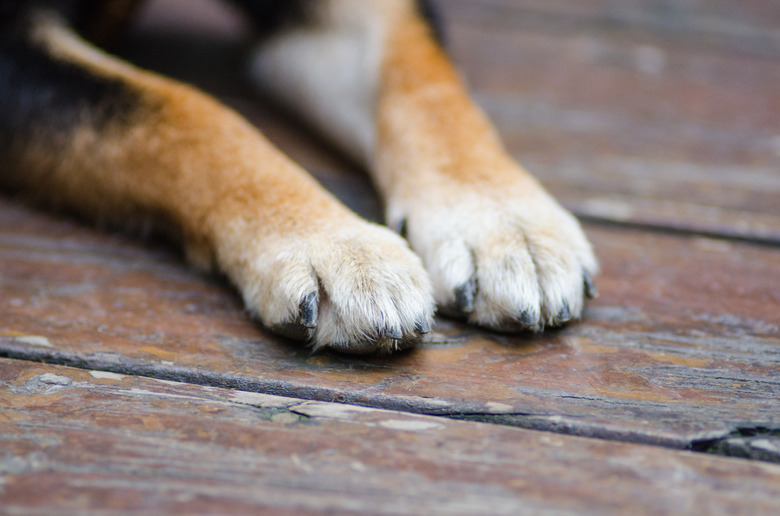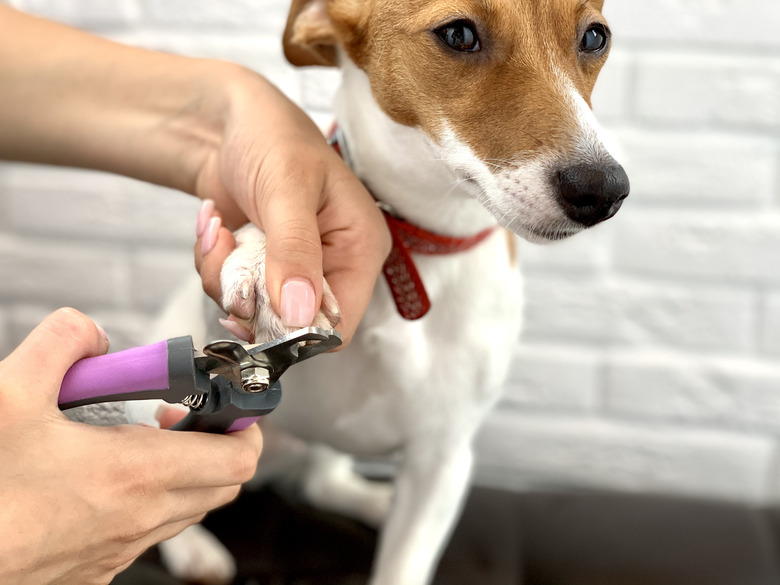Why Are My Dog's Paws Turning Brown? Fur Discoloration Symptoms & Causes
Feet get no respect. These vital appendages are taken for granted until there's a problem — then, it becomes obvious how crucial they are. You may regularly clean your dog's paws, but discoloration doesn't come off with a swipe of a towel. Fur discoloration on a dog's feet is more than cosmetic, but figuring out the cause requires some detective — and veterinary — work.
Why are my dog's paws stained?
Why are my dog's paws stained?
Rust-colored stains may develop if your dog licks their paws constantly. The condition, known as salivary staining, results from a substance in the dog's saliva, called porphyrin. Porphyrin is a pigment found in saliva and in tears. It's a natural byproduct of the breakdown of red blood cells, and the rust color comes from the iron it contains.
White dogs or dogs with light colored fur will show more obvious saliva staining. Pets exposed to more sun may develop darker brown staining. Such discoloration is a symptom of some other disorder, so it's important to take your pet to the veterinarian to receive a definite diagnosis and treatment.
Canine environmental and food allergies
Canine environmental and food allergies
If your dog suffers from allergies, they may exhibit incessant foot-licking. The most common causes of pododermatitis, the catch-all term for canine foot inflammation, are environmental and food allergies. If your dog licks their feet more during certain seasons, such as when certain molds or pollens are present, environmental allergies are the most likely culprit. In climates that are damp part of the year, mold allergies can worsen in winter. When the heater is turned on, mold spores dry out and aerosolize into the home.
Suspected food allergies require an elimination diet for up to 12 weeks to determine whether your dog's food is indeed the cause of their misery. An elimination diet devised by your veterinarian may include a special prescription dog food or meals consisting of a single protein. The latter is generally a relatively uncommon protein that your dog has never been fed, such as venison, kangaroo, or rabbit.
If their food allergies clear up after a few months on the diet, it's safe to assume a more common protein, such as chicken, triggered the reaction. You'll have to control their diet and supplements (since some are flavored with chicken and beef) for the rest of their life, but it's worth the effort to have a happy, comfortable canine.
Parasite infections in dogs
Parasite infections in dogs
Certain parasites, especially worms, may cause pododermatitis. Hookworms are one source, and the larvae penetrate the skin, resulting in intense itching. Dogs can pick up hookworms at the beach if infected animals have defecated there. If left untreated, the footpads become soft, especially around the edges. Nematode larvae may similarly invade the skin between the pads.
Regular deworming with a dewormer like Pancur-C that addresses hookworms should eliminate worm larvae and bring your dog relief. Because larvae may reside in bedding, it's best to either replace your dog's bed or wash and disinfect it thoroughly.
Another parasite causing itching and fur discoloration is the demodectic mange mite. Such mites are normally present deep within dog hair follicles in numbers that don't cause problems, but a compromised immune system may allow these mites to flourish. It can take a considerable amount of time to get demodicosis under control, but it should eventually clear up. Some dogs require lifelong therapy to keep demodicosis at bay.
Yeast infections in dogs
Yeast infections in dogs
When a dog develops a yeast infection, symptoms often show up in the pup's paws. Besides discoloration caused by excessive licking, symptoms include swelling, hair loss, and redness. The dog's nails may turn brown, and a greasy discharge may appear, especially between the toes (top and bottom surfaces) because these areas stay warmer and contain more moisture. A severely affected dog may develop painful abscesses.
Your veterinarian will take skin samples with tape or swabs to perform a skin cytology to confirm a yeast infection. Topical antifungal treatments, including medicated shampoos and wipes, may eradicate a mild yeast infection. Oral antifungal and antibiotic therapy is necessary for dogs with more severe skin infections that involve both yeast and bacteria.
Canine autoimmune diseases
Canine autoimmune diseases
Excessive licking and fur discoloration on a dog's feet may mean your pup is suffering from a serious condition. However, such ailments are usually accompanied by other symptoms, and any lesions on the pup's paws are worse. With pemphigus, for example, the footpad may overgrow and crack. The lymph nodes might swell, and lesions may also appear on the head and ears.
Treatment for an autoimmune condition depends on the diagnosis. With pemphigus, which takes different forms in dogs, antibiotic and corticosteroid therapies are often used. Sun exposure may exacerbate the problem, so dogs should not go outside during the day when the sun's rays are strongest. Other drugs are prescribed depending on the form of pemphigus affecting the animal.
The bottom line
The bottom line
Dog's paws frequently become soiled by grass and mud, but if a bath doesn't remove the brown staining and you see constant paw licking, you might have a more serious issue. Discoloration on a dog's paws can indicate problems such as environmental or food allergies; parasites, like hookworms; a yeast infection; or even an autoimmune condition. All of these can cause intensely itchy paws and may lead to severe complications without intervention, so see your DVM for a diagnosis and treatment.


